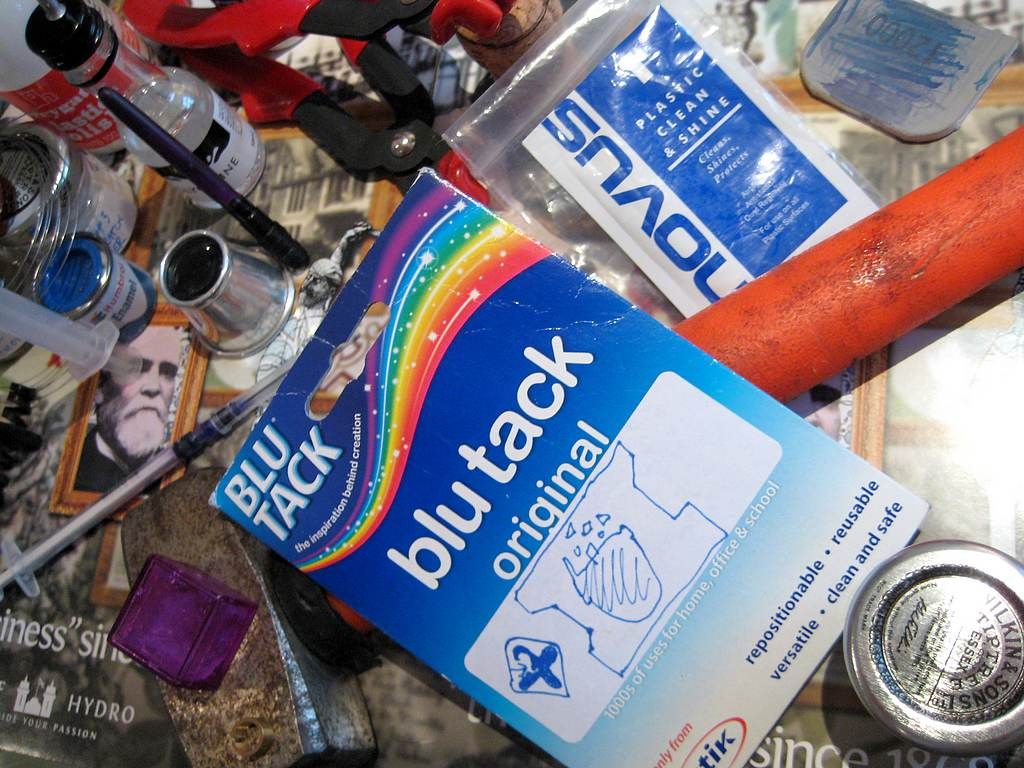 |
| Blutack! A fountain pen Praxis Kit. |
The ochre-hued days of Autumn have drawn to a close. This post has sat in the drafts list too long! Blu Tack, eh? Any introduction would probably be redundant. You know the stuff - squishy, tacky, non toxic play-dough for adults.
I've been consistently surprised by its versatility as a fountain pen diagnostic and repair tool, as you'll probably be too aware of if you frequent the same online forums I enthuse about it on. Formerly scattered around individual threads, I've finally pulled together a list of uses below. Blogger is still shamelessly awful at anchor links, so scroll down to see Blu Tack -
As Section Pliers
As A Third Hand
Cleaning Threads
Removing Friction Fit Nibs And Feeds From Chinese Cartridge Pens
Cleaning Polish Residue From Awkward Spots
Revealing leaks
Removing Cap Jewels
As A Diagnostic Temporary Sealant
As Section Pliers
I can't lay claim to this one, as I'd previously read of Blu Tack's ability to grip and twist off screw down wristwatch case backs (which I can attest to myself, it's quite remarkable).As section pliers, Blu Tack has several splendid qualities. The standout feature is grip. In the photo below, the Blu Tack easily unscrewed a case back from a wristwatch despite being applied only to its thin steel circumference. You'd think it would struggle with such a smooth surface, but it adheres excellently without the need for heavy pressure.
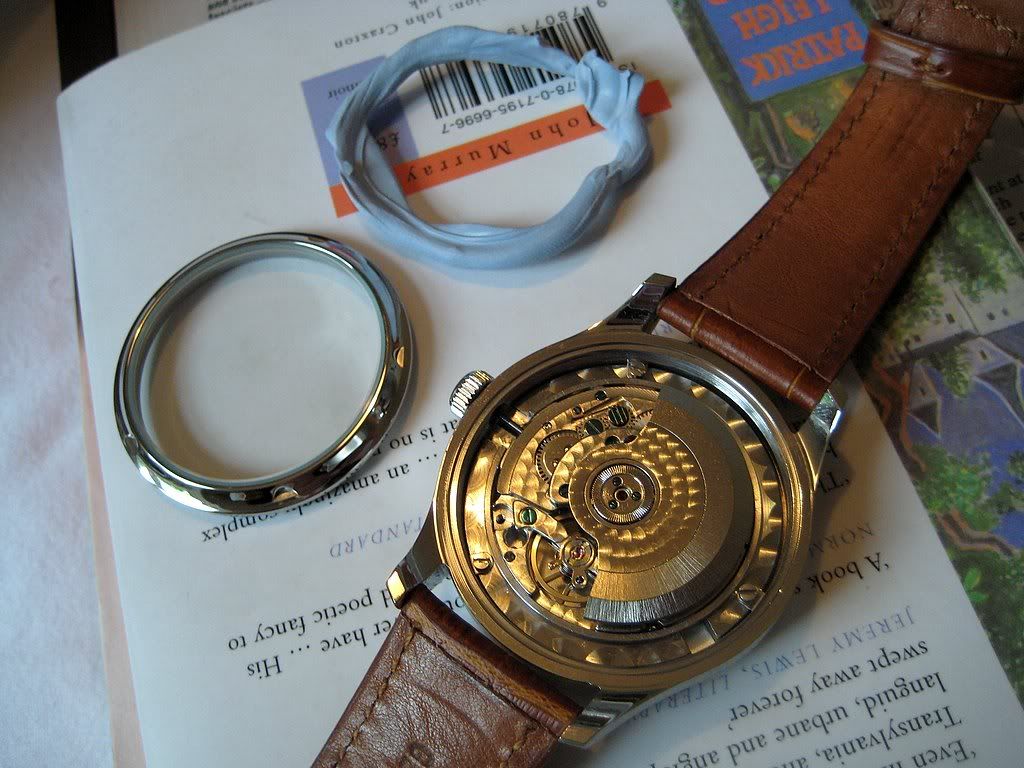 |
| Mere mortal steel holds no fear for Blu Tack! |
Being a malleable putty, there's also no chance of scratching a pen's finish in use. This characteristic also helps maximise the surface area being torqued, molding to complex contours & curves that don't lend themselves particularly well to gripping. This reduces the clamping force the pen has to be subjected to, always a boon with aging materials.
By way of an example, I had a Sheaffer Targa nib unit that needed taken apart, to reseal the leaking inlay (actually, every Targa I've used needed the inlay resealed, barring a sole NOS unit I bought). It was an absolute pig to open. All Targa nib units are made of rather thin injection molded plastic, have a slopey-swoopy shape, and have a threaded join at the cap retention ring. Either the glue bonding this one together was still fresh, or more than the norm was used, or both. Blu Tack's high torque, low clamping pressure qualities broke the glue bond, not the plastic, and left the finish unmarked. Huzzah!
As A Third Hand
A thick blob of Blu Tack really helps when you need extra hands. For instance, I wanted to roll this Summit's badly bent lever flat, which meant having to first extract the J bar and ring. The Blu Tack held the pen steady while my left hand manually pressed the J bar with a thin screwdriver, and my right drew it from the barrel using long nosed pliers.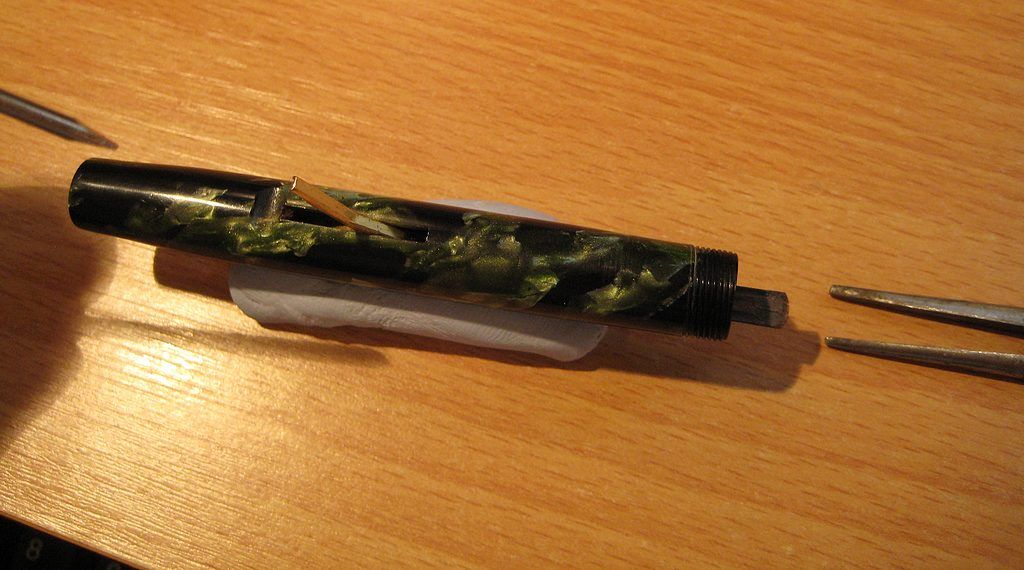 |
| J bar extraction, with blutack in attendance... |
Removing the ring from a celluloid lever filler can be quite scary, especially when the celluloid is this beautiful. Force is being concentrated in a small area of fragile-ish material that may be getting on in years. As well as holding the pen steady as the ring is being compressed, Blu Tack 's compressibility helps cushion the barrel from stress forces in a way the rigid wooden desk below it cannot.
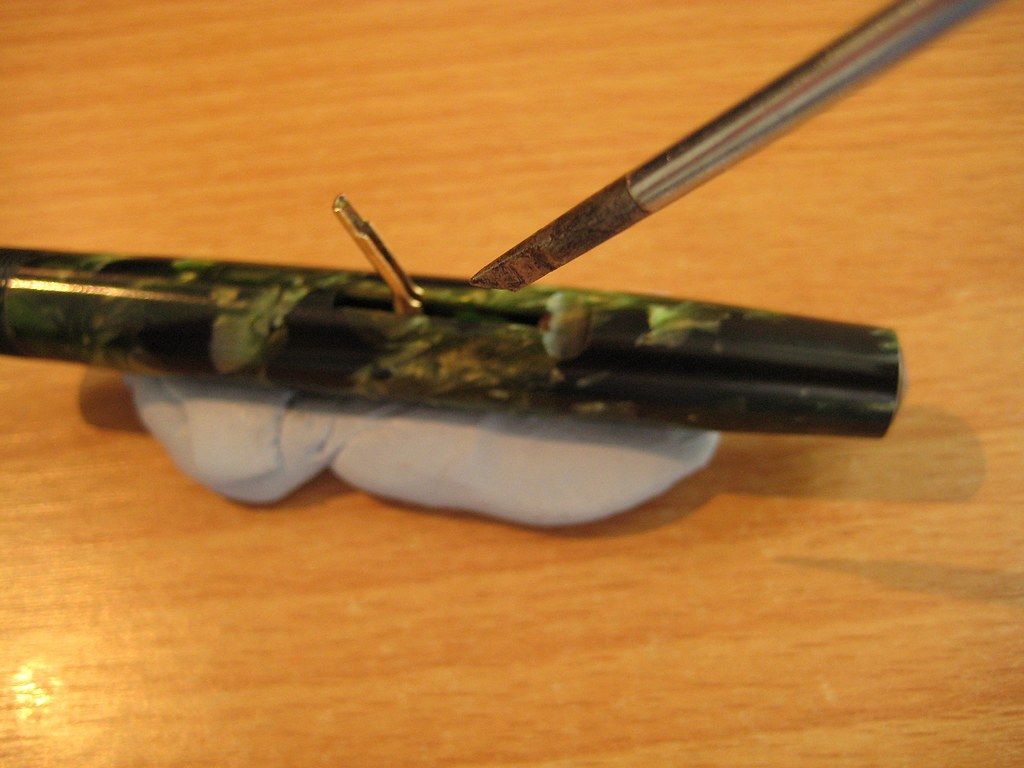 |
| ... then removing the lever's ring. |
Cleaning Threads
I like vintage pens. Back in the day, they were very much tools to be used all day every day, so I find it a surprise they can be so colourful and evocative. On first receipt, the celluloid barrel of the Summit below, for example, puts me in mind of a lush forest floor. The crud lodged in the cap-to-barrel threads, however, put me more in mind of 50 years' worth of nose picking, bum scratching soap-dodgers who may have used the pen before me.Prior to a good wash, a wrap of Blu Tack pressed into the threads, then peeled off, lifts any stubborn manky gunk right out!
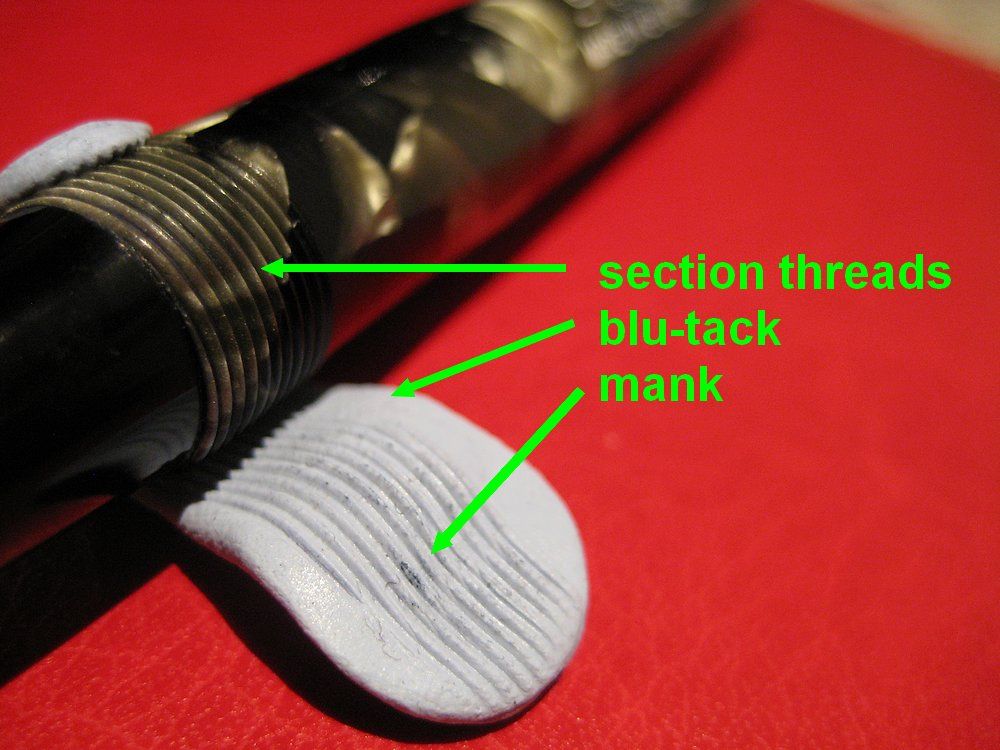 |
| Lifting stubborn, decades old debris from cap - to - barrel threads. To quote Frasier Crane; "Oh dear God!" |
Removing Friction Fit Nibs And Feeds From Chinese Cartridge Pens
Chinese cheapies can be fun and very inexpensive. Sometimes you get a nice surprise that punches well above its weight,sometimes... not. Build quality and tolerances can be all over the place. The vast majority of Chinese cheapies are cartridge fillers with friction fit nibs and feeds.If you happen to find the feed needs work on one, it can be a challenge to remove without marring the nib or breaking the delicate feed fins. The presence of a cartridge nipple makes using a knock out block a bit tricky. A fat blob of Blu Tack fills the fins and protects them from stress, avoids cartridge nipple damage, and keeps ahold of the nib and feed as the section is pulled away from them (see this FPN thread for an example).
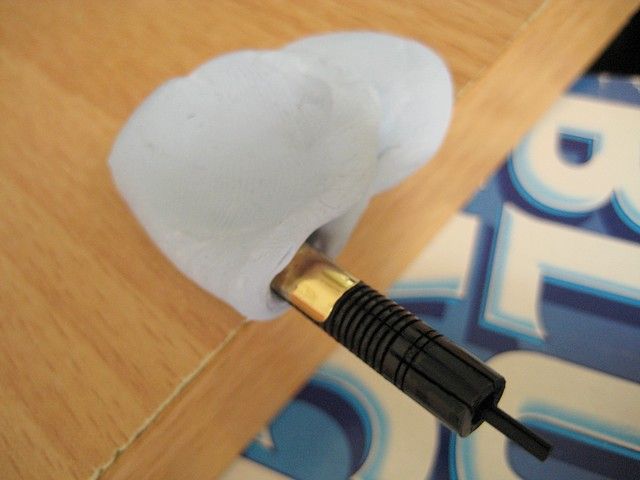 |
| Removing a nib and feed from a Chinese cartridge pen (a Baoer 388). |
Cleaning Out Polish Residue From Awkward Spots
The polishes I use now (Greygate and Novus) don't tend to leave much residue, but for any awkward nooks and crannies (such as the breather hole in the barrel photographed below) Blu Tack will reach where you can't!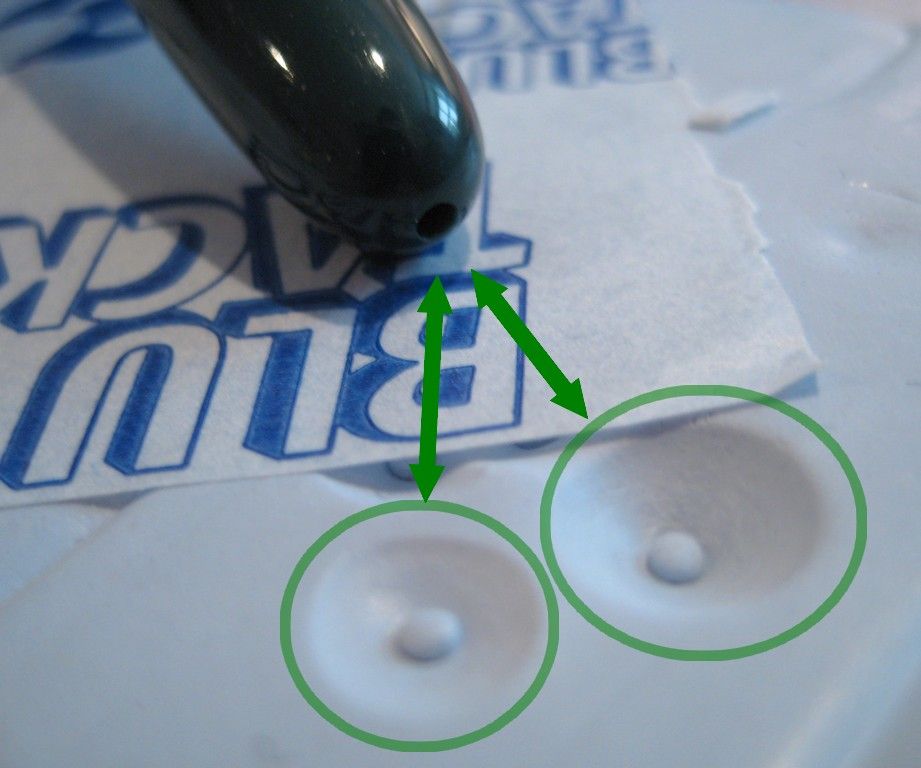 |
| A twirl in a sheet of Blutack pulls polish residue from this Hero 616 barrel breather hole. |
Pinpointing Hard To See Ink Leaks
Can you see the section split in the photo below? I couldn't - and what with having several fountain pens inked at once, finding the finger-staining culprit was a puzzle. Using Blu Tack came to me in a spur-of-the-moment brainwave. A thin length wrapped around the fluted section, then peeled off, revealed a tell-tale ink stain on the Blu Tack, indicating the area that had split. I first wrote this tip on FPN a while ago.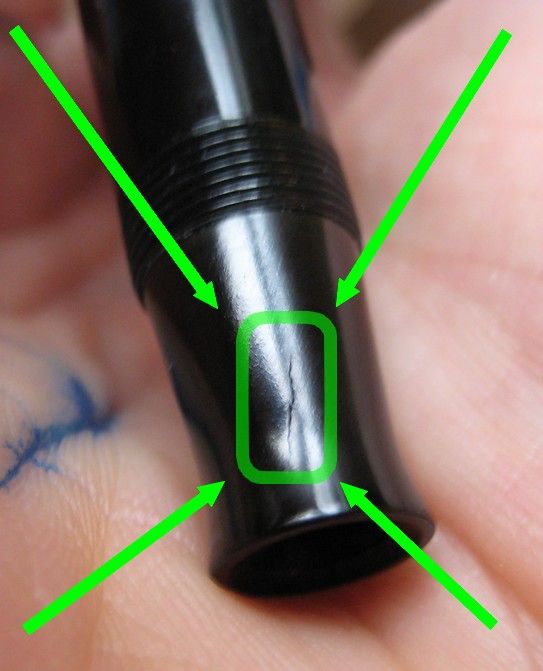 |
| Blutack finds hairline splits your eyes might otherwise miss! The section shown was BHR and so had to be replaced, unfortunately. |
Removing Parker 51 Cap Jewels
I use Blu Tack instead of a rubber pad to unscrew Parker 51 celluloid jewels (heat is still necessary to soften the sealant). A rubber pad is pretty good, as it can slip if the sealant holding the jewel is still too strong, sparing the jewel from breakage. A thin strip (direct out of packet thickness) of Blu Tack goes one better - it can shear, which enables it to act as a rudimentary torque wrench.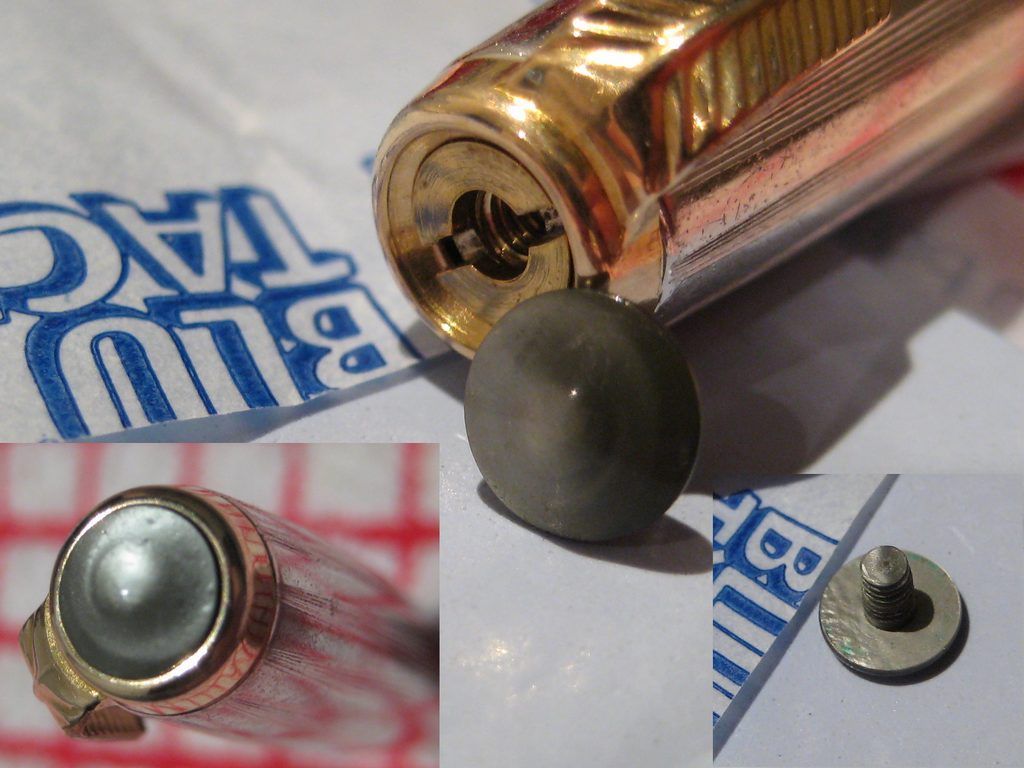 |
| Pressing a Parker 51 cap into a sheet of Blu Tack to unscrew the jewel. |
As A Diagnostic Temporary Sealant
Blu Tack is an excellent temporary barrel seal. It can be applied quickly, leaves nothing to clean off internal threads (as it is not applied to them), seals well, and is easily removed.I'd previously only applied Blu Tack in this way to test self-filler projects so obscure, I never figured anyone else would find the idea useful! When the question came up on FPN, I realised that had I given it some thought, there are plenty of situations where it would be helpful to have a temporary seal; to test aspects of a fountain pen's functionality before permanently sealing, rule out failed rubber gaskets, and so on.
Anyhoo, you simply wrap Blu Tack round the join as shown in the photo below, or this YouTube clip :
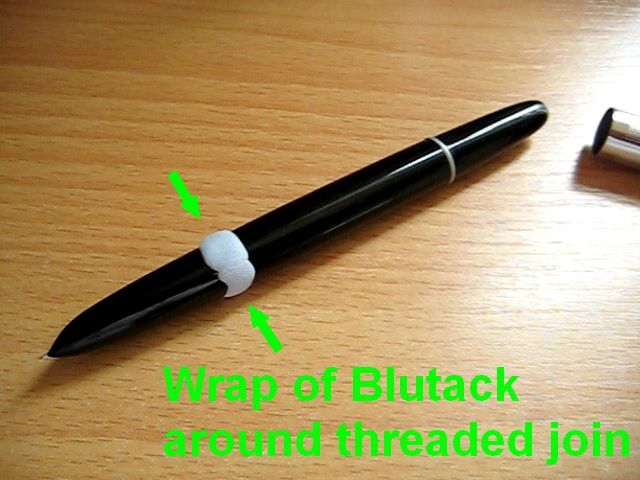 |
| Using Blu Tack to test a Hero 616 vacumatic mod, prior to permanently sealing with shellac. |
I think that's the lot! I can only think of one caveat - wash after use (I tend to clean fountain pen parts after disassembly anyway). Blu Tack can stain wallpaper if left for years, so while any risk is probably non existent, being certain takes very little effort.
Can you think of any more uses? If you've some more of your own you're inclined to share, do leave a comment!
I need to reuse both the blue diamond clip and jewel from an old Parker Vacuumatic to replace the jewel on a pen that is missing one and to swap the clip on another pen.
ReplyDeleteThe trouble is that neither heating and soaking in WD40 nor using a rubber pad and a rubber eraser does the slightest bit of good. I think I am running out of options unless you can tell me more about how to use this Blue Tack stuff. I don't want to shear the jewel, I would like it to come unscrewed.
Hits consistently smooth. Boutiq Carts
ReplyDeleteDisposable vapes come in fun flavor combinations. Boutiq carts
ReplyDelete